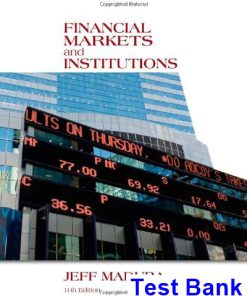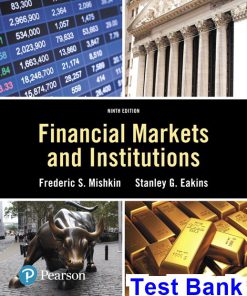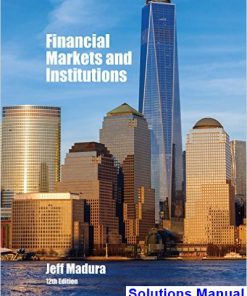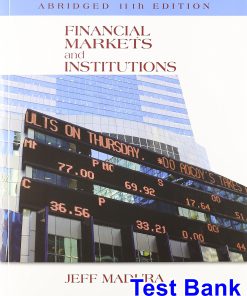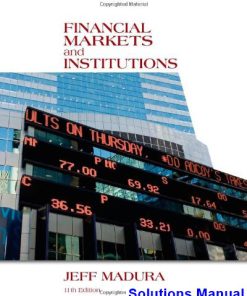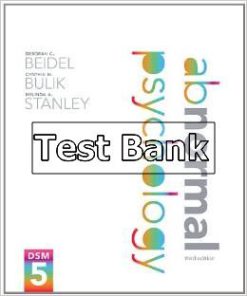Financial Markets and Institutions 9th Edition Madura Test Bank
$26.50$50.00 (-47%)
Financial Markets and Institutions 9th Edition Madura Test Bank.
You may also like
Financial Markets and Institutions 9th Edition Madura Test Bank
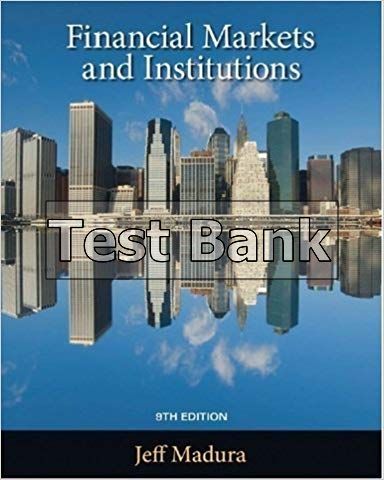
Product details:
- ISBN-10 : 0538482494
- ISBN-13 : 978-0538482493
- Author: Jeff Madura
With its proven conceptual framework and clear presentation, FINANCIAL MARKETS AND INSTITUTIONS, Abridged Ninth Edition (with Stock-Trak coupon), can help you understand why financial markets exist, how financial institutions serve those markets, and the various services those institutions offer. In describing each type of market, the text emphasizes the securities traded in that market and how financial institutions participate in it, while descriptions of financial institutions focus on their management, performance, regulatory aspects, use of financial markets, and sources and uses of funds. Following the introduction of key financial markets and institutions, the text explores the functions of the Federal Reserve System, the major debt security markets, equity security markets, and the derivative security market. Continuing a strong tradition of timely examples and practical applications, the Abridged Ninth Edition includes extensive updates on the global financial and credit crisi
Table contents:
- Part 1 Introduction
- Chapter 1 Why Study Financial Markets and Institutions?
- Preview
- Why Study Financial Markets?
- Debt Markets and Interest Rates
- The Stock Market
- The Foreign Exchange Market
- Why Study Financial Institutions?
- Structure of the Financial System
- Financial Crises
- Central Banks and the Conduct of Monetary Policy
- The International Financial System
- Banks and Other Financial Institutions
- Financial Innovation
- Managing Risk in Financial Institutions
- Applied Managerial Perspective
- How We Will Study Financial Markets and Institutions
- Exploring the Web
- Collecting and Graphing Data
- Web Exercise
- Concluding Remarks
- Summary
- Key Terms
- Questions
- Quantitative Problems
- Web Exercises
- Working with Financial Market Data
- Chapter 2 Overview of the Financial System
- Preview
- Function of Financial Markets
- Structure of Financial Markets
- Debt and Equity Markets
- Primary and Secondary Markets
- Exchanges and Over-the-Counter Markets
- Money and Capital Markets
- Internationalization of Financial Markets
- International Bond Market, Eurobonds, and Eurocurrencies
- World Stock Markets
- Function of Financial Intermediaries: Indirect Finance
- Transaction Costs
- Risk Sharing
- Asymmetric Information: Adverse Selection and Moral Hazard
- Economies of Scope and Conflicts of Interest
- Types of Financial Intermediaries
- Depository Institutions
- Commercial Banks
- Savings and Loan Associations (S&Ls) and Mutual Savings Banks
- Credit Unions
- Contractual Savings Institutions
- Life Insurance Companies
- Fire and Casualty Insurance Companies
- Pension Funds and Government Retirement Funds
- Investment Intermediaries
- Finance Companies
- Mutual Funds
- Money Market Mutual Funds
- Hedge Funds
- Investment Banks
- Regulation of the Financial System
- Increasing Information Available to Investors
- Ensuring the Soundness of Financial Intermediaries
- Restrictions on Entry
- Disclosure
- Restrictions on Assets and Activities
- Deposit Insurance
- Limits on Competition
- Restrictions on Interest Rates
- Financial Regulation Abroad
- Summary
- Key Terms
- Questions
- Web Exercises
- The Financial System
- Part 2 Fundamentals of Financial Markets
- Chapter 3 What Do Interest Rates Mean and What Is Their Role in Valuation?
- Preview
- Measuring Interest Rates
- Present Value
- Four Types of Credit Market Instruments
- Yield to Maturity
- Simple Loan
- Fixed-Payment Loan
- Coupon Bond
- Discount Bond
- Summary
- The Distinction Between Real and Nominal Interest Rates
- The Distinction Between Interest Rates and Returns
- Maturity and the Volatility of Bond Returns: Interest-Rate Risk
- Reinvestment Risk
- Summary
- Calculating Duration
- Duration and Interest-Rate Risk
- Summary
- Key Terms
- Questions
- Quantitative Problems
- Web Exercises
- Understanding Interest Rates
- Chapter 4 Why Do Interest Rates Change?
- Preview
- Determinants of Asset Demand
- Wealth
- Expected Returns
- Risk
- Liquidity
- Theory of Portfolio Choice
- Supply and Demand in the Bond Market
- Demand Curve
- Supply Curve
- Market Equilibrium
- Supply-and-Demand Analysis
- Changes in Equilibrium Interest Rates
- Shifts in the Demand for Bonds
- Wealth
- Expected Returns
- Risk
- Liquidity
- Shifts in the Supply of Bonds
- Expected Profitability of Investment Opportunities
- Expected Inflation
- Government Budget
- Summary
- Key Terms
- Questions
- Quantitative Problems
- Web Exercises
- Interest Rates and Inflation
- Web Appendices
- Chapter 5 How Do Risk and Term Structure Affect Interest Rates?
- Preview
- Risk Structure of Interest Rates
- Default Risk
- Liquidity
- Income Tax Considerations
- Example 5.1 Income Tax Considerations
- Summary
- Term Structure of Interest Rates
- Expectations Theory
- Example 5.2 Expectations Theory
- Example 5.3 Expectations Theory
- Market Segmentation Theory
- Liquidity Premium Theory
- Example 5.4 Liquidity Premium Theory
- Evidence on the Term Structure
- Summary
- Summary
- Key Terms
- Questions
- Quantitative Problems
- Web Exercises
- The Risk and Term Structures of Interest Rates
- Chapter 6 Are Financial Markets Efficient?
- Preview
- The Efficient Market Hypothesis
- Rationale Behind the Hypothesis
- Evidence on the Efficient Market Hypothesis
- Evidence in Favor of Market Efficiency
- Performance of Investment Analysts and Mutual Funds
- Do Stock Prices Reflect Publicly Available Information?
- Random-Walk Behavior of Stock Prices
- Technical Analysis
- Evidence Against Market Efficiency
- Small-Firm Effect
- January Effect
- Market Overreaction
- Excessive Volatility
- Mean Reversion
- New Information Is Not Always Immediately Incorporated into Stock Prices
- Overview of the Evidence on the Efficient Market Hypothesis
- Why the Efficient Market Hypothesis Does Not Imply That Financial Markets Are Efficient
- Behavioral Finance
- Summary
- Key Terms
- Questions
- Quantitative Problems
- Web Exercises
- The Efficient Market Hypothesis
- Part 3 Fundamentals of Financial Institutions
- Chapter 7 Why Do Financial Institutions Exist?
- Preview
- Basic Facts About Financial Structure Throughout The World
- Transaction Costs
- How Transaction Costs Influence Financial Structure
- How Financial Intermediaries Reduce Transaction Costs
- Economies of Scale
- Expertise
- Asymmetric Information: Adverse Selection and Moral Hazard
- The Lemons Problem: How Adverse Selection Influences Financial Structure
- Lemons in the Stock and Bond Markets
- Tools to Help Solve Adverse Selection Problems
- Private Production and Sale of Information
- Government Regulation to Increase Information
- Financial Intermediation
- Collateral and Net Worth
- Summary
- How Moral Hazard Affects the Choice Between Debt and Equity Contracts
- Moral Hazard in Equity Contracts: The Principal–Agent Problem
- Tools to Help Solve the Principal–Agent Problem
- Production of Information: Monitoring
- Government Regulation to Increase Information
- Financial Intermediation
- Debt Contracts
- How Moral Hazard Influences Financial Structure in Debt Markets
- Tools to Help Solve Moral Hazard in Debt Contracts
- Net Worth and Collateral
- Monitoring and Enforcement of Restrictive Covenants
- Financial Intermediation
- Summary
- Conflicts of Interest
- What Are Conflicts of Interest and Why Do We Care?
- Why Do Conflicts of Interest Arise?
- Underwriting and Research in Investment Banking
- Auditing and Consulting in Accounting Firms
- Credit Assessment and Consulting in Credit-Rating Agencies
- What Has Been Done to Remedy Conflicts of Interest?
- Sarbanes-Oxley Act of 2002
- Global Legal Settlement of 2002
- Summary
- Key Terms
- Questions
- Quantitative Problems
- Web Exercises
- Why Do Financial Institutions Exist?
- Chapter 8 Why Do Financial Crises Occur and Why Are They So Damaging to the Economy?
- Preview
- What is a Financial Crisis?
- Agency Theory and the Definition of a Financial Crisis
- Dynamics of Financial Crises
- Stage One: Initial Phase
- Credit Boom and Bust
- Asset-Price Boom and Bust
- Increase in Uncertainty
- Stage Two: Banking Crisis
- Stage Three: Debt Deflation
- Stock Market Crash
- Bank Panics
- Continuing Decline in Stock Prices
- Debt Deflation
- International Dimensions
- Causes of the 2007–2009 Financial Crisis
- Financial Innovation in the Mortgage Markets
- Agency Problems in the Mortgage Markets
- Asymmetric Information and Credit-Rating Services
- Effects of the 2007–2009 Financial Crisis
- Residential Housing Prices: Boom and Bust
- Deterioration of Financial Institutions’ Balance Sheets
- Run on the Shadow Banking System
- Global Financial Markets
- Failure of High-Profile Firms
- Height of the 2007–2009 Financial Crisis
- Summary
- Key Terms
- Questions
- Web Exercises
- Web References
- Part 4 Central Banking and the Conduct of Monetary Policy
- Chapter 9 Central Banks and the Federal Reserve System
- Preview
- Origins of the Federal Reserve System
- Structure of the Federal Reserve System
- Federal Reserve Banks
- Member Banks
- Board of Governors of the Federal Reserve System
- Federal Open Market Committee (FOMC)
- Why the Chair of the Board of Governors Really Runs the Show
- How Independent Is the Fed?
- Should the Fed Be Independent?
- The Case for Independence
- The Case Against Independence
- Central Bank Independence and Macroeconomic Performance Throughout the World
- Explaining Central Bank Behavior
- Structure and Independence of the European Central Bank
- Differences Between the European System of Central Banks and the Federal Reserve System
- Governing Council
- How Independent Is the ECB?
- Structure and Independence of Other Foreign Central Banks
- Bank of Canada
- Bank of England
- Bank of Japan
- The Trend Toward Greater Independence
- Summary
- Key Terms
- Questions and Problems
- Web Exercises
- Structures of the Federal Reserve System and the European System of Central Banks
- Chapter 10 Conduct of Monetary Policy
- Preview
- How Fed Actions Affect Reserves in the Banking System
- Open Market Operations
- Discount Lending
- The Market for Reserves and the Federal Funds Rate
- Demand and Supply in the Market for Reserves
- Demand Curve
- Supply Curve
- Market Equilibrium
- How Changes in the Tools of Monetary Policy Affect the Federal Funds Rate
- Open Market Operations
- Discount Lending
- Reserve Requirements
- Interest on Reserves
- Conventional Monetary Policy Tools
- Open Market Operations
- Discount Policy and the Lender of Last Resort
- Operation of the Discount Window
- Lender of Last Resort
- Reserve Requirements
- Interest on Reserves
- Nonconventional Monetary Policy Tools and Quantitative Easing
- Liquidity Provision
- Large-Scale Asset Purchases
- Quantitative Easing Versus Credit Easing
- Forward Guidance
- Negative Interest Rates on Banks’ Deposits
- Monetary Policy Tools of the European Central Bank
- Open Market Operations
- Lending to Banks
- Interest on Reserves
- Reserve Requirements
- The Price Stability Goal and the Nominal Anchor
- The Role of a Nominal Anchor
- The Time-Inconsistency Problem
- Other Goals of Monetary Policy
- High Employment and Output Stability
- Economic Growth
- Stability of Financial Markets
- Interest-Rate Stability
- Stability in Foreign Exchange Markets
- Should Price Stability Be the Primary Goal of Monetary Policy?
- Hierarchical vs. Dual Mandates
- Price Stability as the Primary, Long-Run Goal of Monetary Policy
- Inflation Targeting
- Advantages of Inflation Targeting
- Disadvantages of Inflation Targeting
- Delayed Signaling
- Too Much Rigidity
- Potential for Increased Output Fluctuations
- Low Economic Growth
- Should Central Banks Respond to Asset-Price Bubbles? Lessons from the Global Financial Crisis
- Two Types of Asset-Price Bubbles
- Credit-Driven Bubbles
- Bubbles Driven Solely by Irrational Exuberance
- The Debate over Whether Central Banks Should Try to Pop Bubbles
- Con: Why Central Banks Should Not Try to Pop Bubbles
- Pro: Why Central Banks Should Try to Pop Bubbles
- Macroprudential Policies
- Monetary Policy
- Summary
- Key Terms
- Questions
- Quantitative Problems
- Web Exercises
- Conduct of Monetary Policy: Tools, Goals, Strategy, and Tactics
- Part 5 Financial Markets
- Chapter 11 The Money Markets
- Preview
- The Money Markets Defined
- Why Do We Need the Money Markets?
- Money Market Cost Advantages
- The Purpose of the Money Markets
- Who Participates in the Money Markets?
- U.S. Treasury Department
- Federal Reserve System
- Commercial Banks
- Businesses
- Investment and Securities Firms
- Investment Companies
- Finance Companies
- Insurance Companies
- Pension Funds
- Individuals
- Money Market Instruments
- Treasury Bills
- Solution
- Risk
- Treasury Bill Auctions
- Treasury Bill Interest Rates
- Federal Funds
- Purpose of Fed Funds
- Terms for Fed Funds
- Federal Funds Interest Rates
- Repurchase Agreements
- The Use of Repurchase Agreements
- Interest Rate on Repos
- Negotiable Certificates of Deposit
- Terms of Negotiable Certificates of Deposit
- History of the CD
- Interest Rate on CDs
- Commercial Paper
- Terms and Issuance
- History of Commercial Paper
- Market for Commercial Paper
- The Role of Asset-Backed Commercial Paper in the Financial Crisis
- Banker’s Acceptances
- Eurodollars
- London Interbank Market
- Eurodollar Certificates of Deposit
- Other Eurocurrencies
- Comparing Money Market Securities
- Interest Rates
- Liquidity
- How Money Market Securities Are Valued
- Summary
- Key Terms
- Questions
- Quantitative Problems
- Web Exercises
- The Money Markets
- Chapter 12 The Bond Market
- Preview
- Purpose of the Capital Market
- Capital Market Participants
- Capital Market Trading
- Types of Bonds
- Treasury Notes and Bonds
- Treasury Bond Interest Rates
- Treasury Inflation-Protected Securities (TIPS)
- Treasury STRIPS
- Agency Bonds
- Municipal Bonds
- Solution
- Risk in the Municipal Bond Market
- Corporate Bonds
- Characteristics of Corporate Bonds
- Restrictive Covenants
- Call Provisions
- Conversion
- Types of Corporate Bonds
- Secured Bonds
- Unsecured Bonds
- Junk Bonds
- Financial Guarantees for Bonds
- Oversight of the Bond Markets
- Current Yield Calculation
- Current Yield
- Solution
- Finding the Value of Coupon Bonds
- Finding the Price of Semiannual Bonds
- Solution
- Solution: Equation
- Solution: Financial Calculator
- Investing in Bonds
- Summary
- Key Terms
- Questions
- Quantitative Problems
- Web Exercise
- The Bond Market
- Chapter 13 The Stock Market
- Preview
- Investing in Stocks
- Common Stock vs. Preferred Stock
- How Stocks Are Sold
- Organized Securities Exchanges
- Over-the-Counter Markets
- Organized vs. Over-the-Counter Trading
- Alternative Trading Systems (ATSs) and Multilateral Trading Facilities (MTFs)
- Exchange Traded Funds
- Computing the Price of Common Stock
- The One-Period Valuation Model
- Solution
- The Generalized Dividend Valuation Model
- The Gordon Growth Model
- Solution
- Price Earnings Valuation Method
- Solution
- How the Market Sets Security Prices
- Errors in Valuation
- Problems with Estimating Growth
- Problems with Estimating Risk
- Problems with Forecasting Dividends
- Stock Market Indexes
- Buying Foreign Stocks
- Regulation of the Stock Market
- The Securities and Exchange Commission
- Summary
- Key Terms
- Questions
- Quantitative Problems
- Web Exercises
- The Stock Market
- Chapter 14 The Mortgage Markets
- Preview
- What are Mortgages?
- Characteristics of the Residential Mortgage
- Mortgage Interest Rates
- Loan Terms
- Collateral
- Down Payments
- Private Mortgage Insurance
- Borrower Qualification
- Mortgage Loan Amortization
- Types of Mortgage Loans
- Insured and Conventional Mortgages
- Fixed-and Adjustable-Rate Mortgages
- Other Types of Mortgages
- Graduated-Payment Mortgages (GPMs)
- Growing-Equity Mortgages (GEMs)
- Second Mortgages (Piggyback)
- Reverse Annuity Mortgages (RAMs)
- Mortgage-Lending Institutions
- Loan Servicing
- Secondary Mortgage Market
- Securitization of Mortgages
- What is a Mortgage-Backed Security?
- Types of Pass-Through Securities
- Government National Mortgage Association (GNMA) Pass-Throughs
- Federal Home Loan Mortgage Corporation (FHLMC) Pass-Throughs
- Private Pass-Throughs (PIPs)
- Subprime Mortgages and CDOs
- The Real Estate Bubble
- Summary
- Key Terms
- Questions
- Quantitative Problems
- Web Exercises
- The Mortgage Markets
- Chapter 15 The Foreign Exchange Market
- Preview
- Foreign Exchange Market
- What Are Foreign Exchange Rates?
- Why Are Exchange Rates Important?
- How Is Foreign Exchange Traded?
- Exchange Rates in the Long Run
- Law of One Price
- Solution
- Theory of Purchasing Power Parity
- Why the Theory of Purchasing Power Parity Cannot Fully Explain Exchange Rates
- Factors That Affect Exchange Rates in the Long Run
- Relative Price Levels
- Trade Barriers
- Preferences for Domestic Versus Foreign Goods
- Productivity
- Exchange Rates in the Short Run: A Supply and Demand Analysis
- Supply Curve for Domestic Assets
- Demand Curve for Domestic Assets
- Equilibrium in the Foreign Exchange Market
- Explaining Changes in Exchange Rates
- Shifts in the Demand for Domestic Assets
- Domestic Interest Rate, iD
- Foreign Interest Rate, i F
- Changes in the Expected Future Exchange Rate, Eet+1
- Recap: Factors That Change the Exchange Rate
- Summary
- Key Terms
- Questions
- Predicting the Future
- Quantitative Problems
- Web Exercises
- The Foreign Exchange Market
- Appendix to Chapter 15 The Interest Parity Condition
- Comparing Expected Returns on Domestic and Foreign Assets
- Interest Parity Condition
- Solution
- Chapter 16 The International Financial System
- Preview
- Intervention in the Foreign Exchange Market
- Foreign Exchange Intervention and Reserves in the Banking System
- Unsterilized Intervention
- Sterilized Intervention
- Balance of Payments
- Exchange Rate Regimes in the International Financial System
- Fixed Exchange Rate Regimes
- How a Fixed Exchange Rate Regime Works
- Devaluation and Revaluation
- Perfect Capital Mobility
- The Policy Trilemma
- Monetary Unions
- Currency Boards and Dollarization
- Speculative Attacks
- Managed Float
- Capital Controls
- Controls on Capital Outflows
- Controls on Capital Inflows
- The Role of the IMF
- Should the IMF Be an International Lender of Last Resort?
- Summary
- Key Terms
- Questions
- Quantitative Problems
- Web Exercise
- The International Financial System
- Part 6 The Financial Institutions Industry
- Chapter 17 Banking and the Management of Financial Institutions
- Preview
- The Bank Balance Sheet
- Liabilities
- Checkable Deposits
- Nontransaction Deposits
- Borrowings
- Bank Capital
- Assets
- Reserves
- Cash Items in Process of Collection
- Deposits at Other Banks
- Securities
- Loans
- Other Assets
- Basic Banking
- General Principles of Bank Management
- Liquidity Management and the Role of Reserves
- Asset Management
- Liability Management
- Capital Adequacy Management
- How Bank Capital Helps Prevent Bank Failure
- How the Amount of Bank Capital Affects Returns to Equity Holders
- Trade-off Between Safety and Returns to Equity Holders
- Bank Capital Requirements
- Off-Balance-Sheet Activities
- Loan Sales
- Generation of Fee Income
- Trading Activities and Risk Management Techniques
- Measuring Bank Performance
- Bank’s Income Statement
- Operating Income
- Operating Expenses
- Income
- Measures of Bank Performance
- Recent Trends in Bank Performance Measures
- Summary
- Key Terms
- Questions
- Quantitative Problems
- Web Exercises
- Banking and the Management of Financial Institutions
- Chapter 18 Financial Regulation
- Preview
- Asymmetric Information as a Rationale for Financial Regulation
- Government Safety Net
- Bank Panics and the Need for Deposit Insurance
- Other Forms of the Government Safety Net
- Moral Hazard and the Government Safety Net
- Adverse Selection and the Government Safety Net
- Too Big to Fail
- Financial Consolidation and the Government Safety Net
- Types of Financial Regulation
- Restrictions on Asset Holdings
- Capital Requirements
- Prompt Corrective Action
- Financial Supervision: Chartering and Examination
- Assessment of Risk Management
- Disclosure Requirements
- Consumer Protection
- Restrictions on Competition
- Macroprudential Versus Microprudential Supervision
- Summary
- Banking Crises Throughout the World in Recent Years
- “Déjà Vu All Over Again”
- The Dodd-Frank Wall Street Reform and Consumer Protection Act of 2010
- Dodd-Frank
- Consumer Protection
- Resolution Authority
- Systemic Risk Regulation
- Volcker Rule
- Derivatives
- Too-Big-to-Fail and Future Regulation
- What Can Be Done About the Too-Big-to-Fail Problem?
- Break Up Large, Systemically Important Financial Institutions
- Higher Capital Requirements
- Leave It to Dodd-Frank
- Other Issues for Future Regulation
- Compensation in the Financial Services Industry
- Government-Sponsored Enterprises (GSEs)
- Credit-Rating Agencies
- The Danger of Overregulation
- Summary
- Key Terms
- Questions
- Quantitative Problems
- Web Exercises
- Banking Regulation
- Web Appendix
- Chapter 19 Banking Industry: Structure and Competition
- Preview
- Historical Development of the Banking System
- Multiple Regulatory Agencies
- Financial Innovation and the Growth of the Shadow Banking System
- Responses to Changes in Demand Conditions: Interest Rate Volatility
- Adjustable-Rate Mortgages
- Financial Derivatives
- Responses to Changes in Supply Conditions: Information Technology
- Bank Credit and Debit Cards
- Electronic Banking
- Electronic Payment
- E-Money
- Junk Bonds
- Commercial Paper Market
- Securitization and the Shadow Banking System
- How the Shadow Banking System Works
- Subprime Mortgage Market
- Avoidance of Existing Regulations
- Money Market Mutual Funds
- Sweep Accounts
- Financial Innovation and the Decline of Traditional Banking
- Decline in Cost Advantages in Acquiring Funds (Liabilities)
- Decline in Income Advantages on Uses of Funds (Assets)
- Banks’ Responses
- Decline of Traditional Banking in Other Industrialized Countries
- Structure of the U.S. Banking Industry
- Restrictions on Branching
- Response to Branching Restrictions
- Bank Holding Companies
- Automated Teller Machines
- Bank Consolidation and Nationwide Banking
- The Riegle-Neal Interstate Banking and Branching Efficiency Act of 1994
- What Will the Structure of the U.S. Banking Industry Look Like in the Future?
- Are Bank Consolidation and Nationwide Banking Good Things?
- Separation of the Banking and Other Financial Service Industries
- Erosion of Glass-Steagall
- The Gramm-Leach-Bliley Financial Services Modernization Act of 1999: Repeal of Glass-Steagall
- Implications for Financial Consolidation
- Separation of Banking and Other Financial Services Industries Throughout the World
- Thrift Industry
- Savings and Loan Associations
- Mutual Savings Banks
- Credit Unions
- International Banking
- Eurodollar Market
- Structure of U.S. Banking Overseas
- Foreign Banks in the United States
- Summary
- Key Terms
- Questions
- Web Exercises
- Banking Industry: Structure and Competition
- Chapter 20 The Mutual Fund Industry
- Preview
- The Growth of Mutual Funds
- The First Mutual Funds
- Benefits of Mutual Funds
- Ownership of Mutual Funds
- Mutual Fund Structure
- Open-Versus Closed-End Funds
- Organizational Structure
- Investment Objective Classes
- Equity Funds
- Bond Funds
- Hybrid Funds
- Money Market Funds
- Index Funds
- Fee Structure of Investment Funds
- Regulation of Mutual Funds
- Hedge Funds
- Conflicts of Interest in the Mutual Fund Industry
- Sources of Conflicts of Interest
- Mutual Fund Abuses
- Government Response to Abuses
- Summary
- Key Terms
- Questions
- Quantitative Problems
- Web Exercises
- Investment Banks, Brokerage Firms, and Mutual Funds
- Chapter 21 Insurance Companies and Pension Funds
- Preview
- Insurance Companies
- Fundamentals of Insurance
- Adverse Selection and Moral Hazard in Insurance
- Selling Insurance
- Growth and Organization of Insurance Companies
- Types of Insurance
- Life Insurance
- Term Life
- Whole Life
- Universal Life
- Annuities
- Assets and Liabilities of Life Insurance Companies
- Health Insurance
- Property and Casualty Insurance
- Property and Casualty Insurance Today
- Reinsurance
- Terrorism Risk Insurance Act of 2002
- Insurance Regulation
- Credit Default Swaps
- Monoline Insurance
- Pensions
- Types of Pensions
- Defined-Benefit Pension Plans
- Defined-Contribution Pension Plans
- Private and Public Pension Plans
- Regulation of Pension Plans
- Employee Retirement Income Security Act
- Individual Retirement Plans
- The Future of Pension Funds
- Summary
- Key Terms
- Questions
- Quantitative Problems
- Web Exercises
- Insurance Companies and Pension Funds
- Chapter 22 Investment Banks, Security Brokers and Dealers, and Venture Capital Firms
- Preview
- Investment Banks
- Background
- Underwriting Stocks and Bonds
- Giving Advice
- Filing Documents
- Underwriting
- Best Efforts
- Private Placements
- Equity Sales
- Mergers and Acquisitions
- Securities Brokers and Dealers
- Brokerage Services
- Securities Orders
- Other Services
- Full-Service vs. Discount Brokers
- Securities Dealers
- Regulation of Securities Firms
- Relationship Between Securities Firms and Commercial Banks
- Private Equity Investment
- Venture Capital Firms
- Description of Industry
- Venture Capitalists Reduce Asymmetric Information
- Origins of Venture Capital
- Structure of Venture Capital Firms
- The Life of a Deal
- Fundraising
- Investing
- Exiting
- Venture Fund Profitability
- Private Equity Buyouts
- Advantages to Private Equity Buyouts
- Life Cycle of the Private Equity Buyout
- Summary
- Key Terms
- Questions
- Quantitative Problems
- Web Exercises
- Investment Banks, Security Brokers and Dealers, and Venture Capital Firms
- Part 7 The Management of Financial Institutions
- Chapter 23 Risk Management in Financial Institutions
- Preview
- Managing Credit Risk
- Screening and Monitoring
- Screening
- Specialization in Lending
- Monitoring and Enforcement of Restrictive Covenants
- Long-Term Customer Relationships
- Loan Commitments
- Collateral
- Compensating Balances
- Credit Rationing
- Managing Interest-Rate Risk
- Income Gap Analysis
- Solution
- Solution
- Duration Gap Analysis
- Solution
- Solution
- Solution
- Example of a Nonbanking Financial Institution
- Some Problems with Income Gap and Duration Gap Analyses
- Summary
- Key Terms
- Questions
- Quantitative Problems
- Web Exercises
- Risk Management in Financial Institutions
- Chapter 24 Hedging with Financial Derivatives
- Preview
- Hedging
- Forward Markets
- Interest-Rate Forward Contracts
- Pros and Cons of Forward Contracts
- Financial Futures Markets
- Financial Futures Contracts
- Organization of Trading in Financial Futures Markets
- Globalization of Financial Futures Markets
- Explaining the Success of Futures Markets
- Stock Index Futures
- Stock Index Futures Contracts
- Options
- Option Contracts
- Profits and Losses on Option and Futures Contracts
- Factors Affecting the Prices of Option Premiums
- Summary
- Interest-Rate Swaps
- Interest-Rate Swap Contracts
- Advantages of Interest-Rate Swaps
- Disadvantages of Interest-Rate Swaps
- Financial Intermediaries in Interest-Rate Swaps
- Credit Derivatives
- Credit Options
- Credit Swaps
- Credit-Linked Notes
- Summary
- Key Terms
- Questions
- Quantitative Problems
- Web Exercise
- Hedging with Financial Derivatives
- Web Appendices
- Glossary
- Index
People also search:
financial markets and institutions 9th edition
financial markets and institutions 9th edition pdf
financial markets and institutions 9th edition solutions manual pdf
financial markets and institutions 9th edition test bank
financial markets and institutions 9th edition mishkin test bank

